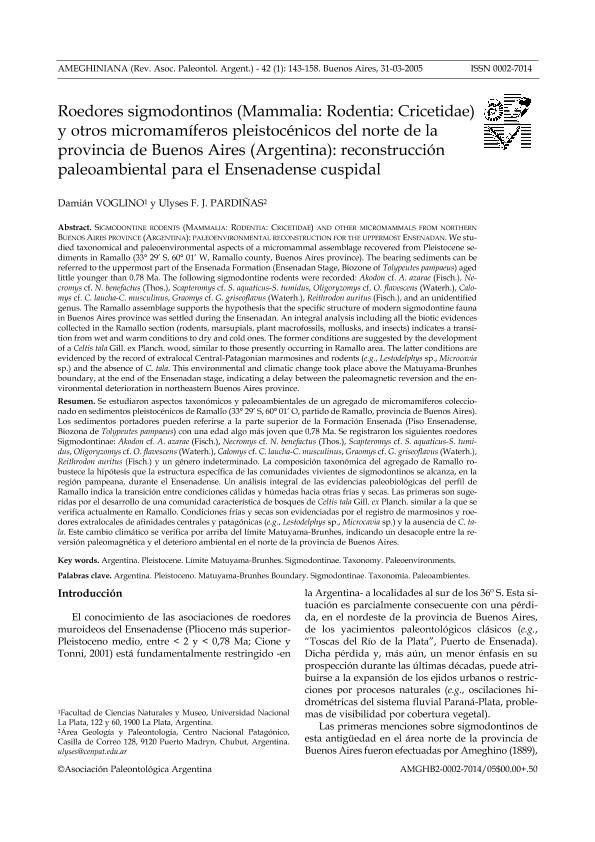Mostrar el registro sencillo del ítem
dc.contributor.author
Voglino, Damián

dc.contributor.author
Pardiñas, Ulises Francisco J.

dc.date.available
2020-05-26T20:26:02Z
dc.date.issued
2005-12
dc.identifier.citation
Voglino, Damián; Pardiñas, Ulises Francisco J.; Roedores sigmodontinos (Mammalia: Rodentia: Cricetidae) y otros micromamíferos pleistocénicos del norte de la provincia de Buenos Aires (Argentina) : reconstrucción paleoambiental para el Ensenadense cuspidal; Asociación Paleontológica Argentina; Ameghiniana; 42; 1; 12-2005; 143-158
dc.identifier.issn
0002-7014
dc.identifier.uri
http://hdl.handle.net/11336/105943
dc.description.abstract
Se estudiaron aspectos taxonómicos y paleoambientales de un agregado de micromamíferos coleccionado en sedimentos pleistocénicos de Ramallo (33° 29’ S, 60° 01’ O, partido de Ramallo, provincia de Buenos Aires). Los sedimentos portadores pueden referirse a la parte superior de la Formación Ensenada (Piso Ensenadense, Biozona de Tolypeutes pampaeus) con una edad algo más joven que 0,78 Ma. Se registraron los siguientes roedores Sigmodontinae: Akodon cf. A. azarae (Fisch.), Necromys cf. N. benefactus (Thos.), Scapteromys cf. S. aquaticus-S. tumidus, Oligoryzomys cf. O. flavescens (Waterh.), Calomys cf. C. laucha-C. musculinus, Graomys cf. G. griseoflavus (Waterh.), Reithrodon auritus (Fisch.) y un género indeterminado. La composición taxonómica del agregado de Ramallo robustece la hipótesis que la estructura específica de las comunidades vivientes de sigmodontinos se alcanza, en la región pampeana, durante el Ensenadense. Un análisis integral de las evidencias paleobiológicas del perfil de Ramallo indica la transición entre condiciones cálidas y húmedas hacia otras frías y secas. Las primeras son sugeridas por el desarrollo de una comunidad característica de bosques de Celtis tala Gill. ex Planch. similar a la que se verifica actualmente en Ramallo. Condiciones frías y secas son evidenciadas por el registro de marmosinos y roedores extralocales de afinidades centrales y patagónicas (e.g., Lestodelphys sp., Microcavia sp.) y la ausencia de C. tala. Este cambio climático se verifica por arriba del límite Matuyama-Brunhes, indicando un desacople entre la reversión paleomagnética y el deterioro ambiental en el norte de la provincia de Buenos Aires.
dc.description.abstract
We studied taxonomical and paleoenvironmental aspects of a micromammal assemblage recovered from Pleistocene sediments in Ramallo (33° 29’ S, 60° 01’ W, Ramallo county, Buenos Aires province). The bearing sediments can be referred to the uppermost part of the Ensenada Formation (Ensenadan Stage, Biozone of Tolypeutes pampaeus) aged little younger than 0.78 Ma. The following sigmodontine rodents were recorded: Akodon cf. A. azarae (Fisch.), Necromys cf. N. benefactus (Thos.), Scapteromys cf. S. aquaticus-S. tumidus, Oligoryzomys cf. O. flavescens (Waterh.), Calomys cf. C. laucha-C. musculinus, Graomys cf. G. griseoflavus (Waterh.), Reithrodon auritus (Fisch.), and an unidentified genus. The Ramallo assemblage supports the hypothesis that the specific structure of modern sigmodontine fauna in Buenos Aires province was settled during the Ensenadan. An integral analysis including all the biotic evidences collected in the Ramallo section (rodents, marsupials, plant macrofossils, mollusks, and insects) indicates a transition from wet and warm conditions to dry and cold ones. The former conditions are suggested by the development of a Celtis tala Gill. ex Planch. wood, similar to those presently occurring in Ramallo area. The latter conditions are evidenced by the record of extralocal Central-Patagonian marmosines and rodents (e.g., Lestodelphys sp., Microcavia sp.) and the absence of C. tala. This environmental and climatic change took place above the Matuyama-Brunhes boundary, at the end of the Ensenadan stage, indicating a delay between the paleomagnetic reversion and the environmental deterioration in northeastern Buenos Aires province.IGMODONTINE RODENTS (MAMMALIA: RODENTIA: CRICETIDAE) AND OTHER MICROMAMMALS FROM NORTHERNBUENOS AIRES PROVINCE (ARGENTINA): PALEOENVIRONMENTAL RECONSTRUCTION FOR THE UPPERMOST ENSENADAN. We studied taxonomical and paleoenvironmental aspects of a micromammal assemblage recovered from Pleistocene sediments in Ramallo (33° 29’ S, 60° 01’ W, Ramallo county, Buenos Aires province). The bearing sediments can be referred to the uppermost part of the Ensenada Formation (Ensenadan Stage, Biozone of Tolypeutes pampaeus) aged little younger than 0.78 Ma. The following sigmodontine rodents were recorded: Akodon cf. A. azarae (Fisch.), Necromys cf. N. benefactus (Thos.), Scapteromys cf. S. aquaticus-S. tumidus, Oligoryzomys cf. O. flavescens (Waterh.), Calomys cf. C. laucha-C. musculinus, Graomys cf. G. griseoflavus (Waterh.), Reithrodon auritus (Fisch.), and an unidentified genus. The Ramallo assemblage supports the hypothesis that the specific structure of modern sigmodontine fauna in Buenos Aires province was settled during the Ensenadan. An integral analysis including all the biotic evidences collected in the Ramallo section (rodents, marsupials, plant macrofossils, mollusks, and insects) indicates a transition from wet and warm conditions to dry and cold ones. The former conditions are suggested by the development of a Celtis tala Gill. ex Planch. wood, similar to those presently occurring in Ramallo area. The latter conditions are evidenced by the record of extralocal Central-Patagonian marmosines and rodents (e.g., Lestodelphys sp., Microcavia sp.) and the absence of C. tala. This environmental and climatic change took place above the Matuyama-Brunhes boundary, at the end of the Ensenadan stage, indicating a delay between the paleomagnetic reversion and the environmental deterioration in northeastern Buenos Aires province.
dc.format
application/pdf
dc.language.iso
spa
dc.publisher
Asociación Paleontológica Argentina

dc.rights
info:eu-repo/semantics/openAccess
dc.rights.uri
https://creativecommons.org/licenses/by-nc-sa/2.5/ar/
dc.subject
ARGENTINA
dc.subject
PLEISTOCENO
dc.subject
MATUYAMA-BRUNHES BOUNDARY
dc.subject
SIGMODONTINAE
dc.subject.classification
Otras Ciencias de la Tierra y relacionadas con el Medio Ambiente

dc.subject.classification
Ciencias de la Tierra y relacionadas con el Medio Ambiente

dc.subject.classification
CIENCIAS NATURALES Y EXACTAS

dc.title
Roedores sigmodontinos (Mammalia: Rodentia: Cricetidae) y otros micromamíferos pleistocénicos del norte de la provincia de Buenos Aires (Argentina) : reconstrucción paleoambiental para el Ensenadense cuspidal
dc.title
Sigmodontine rodents (mammalia: rodentia: cricetidae) and other micromammals from Northern Buenos Aires province (Argentina) : paleoenvironmental reconstruction for the uppermost Ensenadan
dc.type
info:eu-repo/semantics/article
dc.type
info:ar-repo/semantics/artículo
dc.type
info:eu-repo/semantics/publishedVersion
dc.date.updated
2020-05-05T14:11:06Z
dc.identifier.eissn
1851-8044
dc.journal.volume
42
dc.journal.number
1
dc.journal.pagination
143-158
dc.journal.pais
Argentina

dc.journal.ciudad
Ciudad Autónoma de Buenos Aires
dc.description.fil
Fil: Voglino, Damián. Universidad Nacional de La Plata; Argentina
dc.description.fil
Fil: Pardiñas, Ulises Francisco J.. Consejo Nacional de Investigaciones Científicas y Técnicas. Centro Científico Tecnológico Conicet - Centro Nacional Patagónico; Argentina
dc.journal.title
Ameghiniana

dc.relation.alternativeid
info:eu-repo/semantics/altIdentifier/url/http://www.ameghiniana.org.ar/index.php/ameghiniana/article/view/878/
Archivos asociados
